#chûkei
Explore tagged Tumblr posts
Text
Other formal outfits of Heian ancestry - Kariginu, Hoi and Nôshi attires
(as worn by samurai of the Edo period - great charts by Nadeshico Rin). You can find more about samurai ranks and their regulated attires under the tag "samurai kimono".
The Kariginu
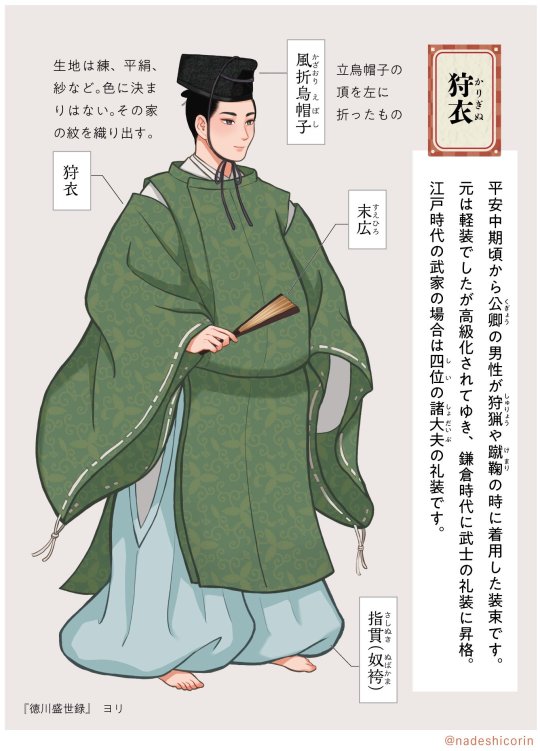
狩衣 Kariginu first appeared during Heian period where they were informal attires worn by kuge (nobibilty) men for activities such as hunting and 蹴鞠 kemari ball games.
Kariginu rose to formal status during Kamakura period when it started being worn by the buke (warrior class). In Edo period, it was worn by upper-ranked samurai (4th rank and above).
Edo-period kariginu designates a patterned clothing (different from the hoi, see below), often decorated with the family 紋 mon (crest). Colors were not regulated.
風折烏帽子 Kazaori-eboshi - black-lacquered hat made of silk, cloth or paper, originally worn by Heian nobility. Many eboshi shapes exist, this one is a upright style (tate-eboshi 立烏帽子) with top folded to the left.
末広 Suehiro - a type of formal folding fan. TN: the fan drawn here ressemble more a 中啓 chûkei, as suehiro have curving ribs which don't seems to be the case here (find more about fan types here)
指貫 sashinuki (or 奴袴 nubakama) - large bouffant pants. Also, note the bare feet! Rin doesn't comment this but this was probably a way to put it below sokutai and ikan (which do have socks)
袖括 Sodekukuri - decorative sleeve ties. Originally appeared on Heian clothings (like kariginu, nôshi, etc) where they were used to tighten sleeve cuffs.
The Hoi
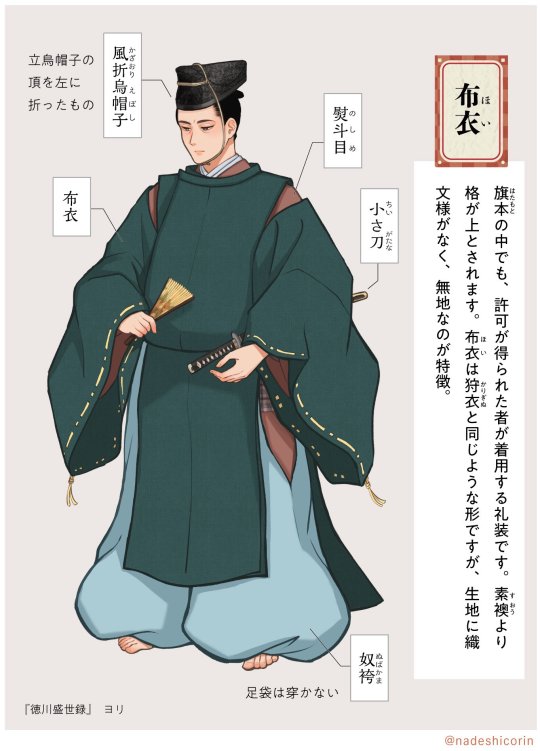
布衣 Hoi is a variation of 狩衣 kariginu (see above).
During Edo period, it was worn by some hatamoto (6th rank samurai) via explicit permission of the shogunate - setting those rewarded by this honor apart from other vassals of the same rank.
Compared to kariginu, hoi were plain solid color.
It is worn here over a 熨斗目 noshime, a samurai kosode (=ancestor of the kimono) with stripes or lattice pattern at waist area.
As for the kariginu, note the bare feet!
The Nôshi
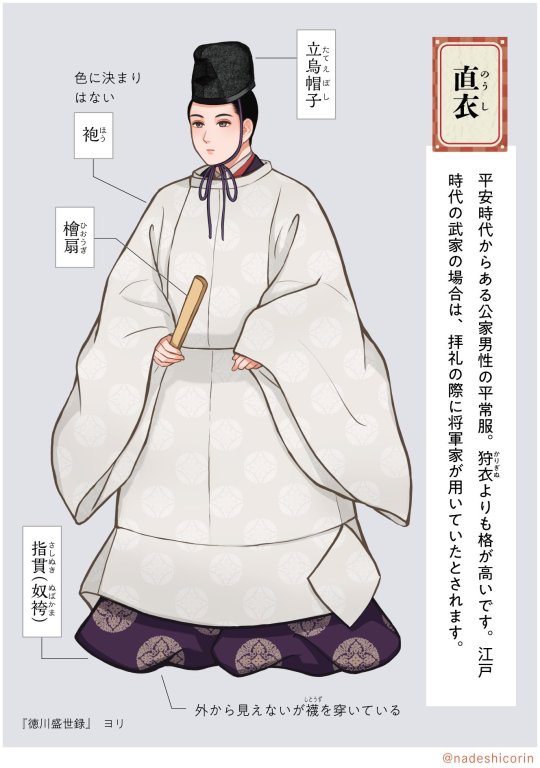
直衣 Nôshi was a type of everyday robes which were first worn by males of the imperial family during Heian era. Formality placed it then above kariginu.
Overtime, their use spread among nobility, and by Edo period, they were a "tad-formal" attire worn by Shogun's family for worship celebrations.
立烏帽子 Tate-eboshi - upright lacquered hat
袍 Hô - round-necked robe with large boxy sleeves
檜扇 hiôgi - formal folding fan made of cypress, also of Heian history. Those were unpatterned as painted ones were for women
指貫 Sashinuki (or 奴袴 nubakama) - large bouffant pants
#japan#fashion#fashion history#samurai kimono#samurai#nadeshico rin#ressources#reference#kariginu#hoi#noshime#hatamoto#buke#warrior class#edo era#edo period#heian period#着物#Kazaori-eboshi#Suehiro#chûkei#sashinuki#nubakama#Sodekukuri#men kimono#Tate-eboshi#Hô#hiôgi#Sashinuki
257 notes
·
View notes
Text
Priests' outfits - Jikitotsu, Daimon, and Hentetsu
(as worn during Edo period - great charts by Nadeshico Rin). You can find more about samurai ranks and their regulated attires under the tag "samurai kimono".
"Hight Priest" jikitotsu
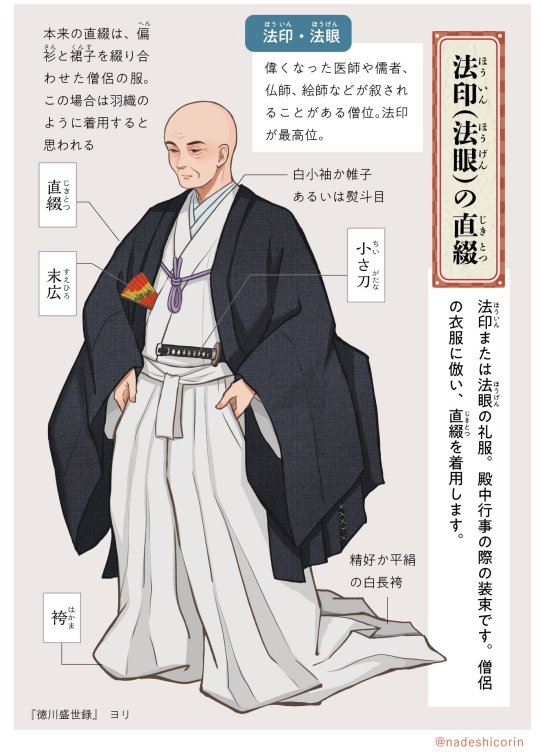
This outfit was worn for court events by Buddhist priests of the highest rank ( 法印 Hôin) and second highest rank (法眼 Hôgen). Those titles could also be also given to 儒者 Confucian scholars, 医師doctors, Buddhist 絵師 painters and 仏師 sculptors, etc.
直綴 Jikitotsu - type of monk robe, originally made by stitching together a 偏衫 henzan (monk robe covering the upper body) and a 裙子 kunsu (monk robe covering the lower body) together. Overtime, jikitotsu came to be worn opened, more like a haori vest.
末広 Suehiro - a type of formal folding fan. TN: the fan drawn here ressemble more a 中啓 chûkei, as suehiro have curving ribs which don't seems to be the case here (find more about fan types here)
(長)袴 (Naga)bakama - hakama pants with long trailing legs, here made of hiraginu (plain silk)
白小袖 Shiro-Kosode - white kosode (=ancestor of the kimono) /or/ 帷子 Katabira - thin garment made from hemp or raw silk (worn during Summer). Note that 経帷子 kyôkatabira designates a shroud (=the white kimono used to dress the dead). /or/ 熨斗目Noshime - kosode (=ancestor of the kimono) with stripes/lattice pattern at waist area
小さ刀 Chîsagatana - small katana
"Companion" formal kimono
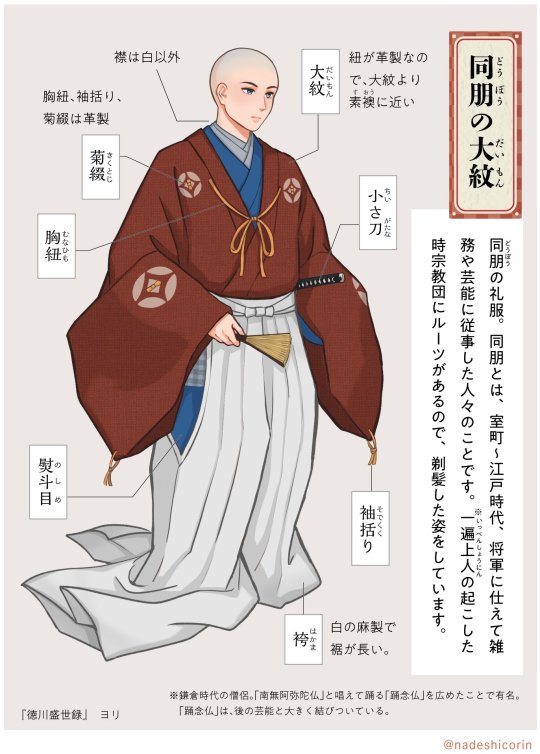
First people helping buddhist priests, 同朋 dôbô (lit. "companions) became overtime men attending on the Shogun, feudal lords and other high-ranked officals.
They were in charge of miscellaneous tasks (like cleaning, messengers etc.), or depending on their talents more skilled ones (dance, music, ikebana, tea ceremony etc.).
大紋 Daimon is a specific hitatare set, patterned with large 紋 mon (clan/family crests)
菊綴 Kikutoji - decorative tassel-like knots, first appeared on Heian nobility clothes. Here, those were leather ones
胸紐 Munahimo - chest ties, first appeared on Heian nobility clothes. Here, those were leather ones
熨斗目 Noshime - kosode (=ancestor of the kimono) with stripes or lattice pattern at waist area. Also note the colored undergarments collars.
袖括 Sodekukuri - decorative sleeve ties. Originally appeared on Heian clothings (like kariginu, nôshi, etc) where they were used to tighten sleeve cuffs. Here, those were leather ones
(長)袴 (Naga)bakama - hakama pants with long trailing legs, here made of white linen
小さ刀 Chîsagatana - small katana
The Proto-haori

This outfit was the formal wear worn by lower class priests, scholars, doctors, artists, etc.
編綴 Hentetsu (lit. "stitched together") - a vest with large and long boxy sleeves, made from gauze or plain silk, most often black or dark brown. The chest straps were also made of the same fabric It evolved from 十徳 jittoku (itself a variation of 直綴 jikitotsu, see above). First a casual wear for court nobles, and then spread to lower-class samurai who wore it over their kosode from Muromachi era and on. Its use then reached other social classes during Edo period. Overtime and minor variations, it finally became known as our modern 羽織 haori
服紗(小袖) Fukusa(kosode) - a kosode (=ancestor of the kimono) bearing crest, and made from soft silk (like habutae or rinzu). In summer, it was a katabira (thin garment made from hemp or raw silk) /or/ 熨斗目 Noshime - kosode (=ancestor of the kimono) with stripes or lattice pattern at waist area
#japan#history#fashion#samurai kimono#nadeshico rin#samurai#edo era#edo period#ressources#references#men kimono#着物#buddhist priest#monk#jikitotsu#henzan#kunsu#Suehiro#chûkei#nagabakama#kosode#Katabira#Noshime#Chîsagatana#dôbô#Daimon#Kikutoji#munahimo#Sodekukuri#Hentetsu
229 notes
·
View notes
Photo
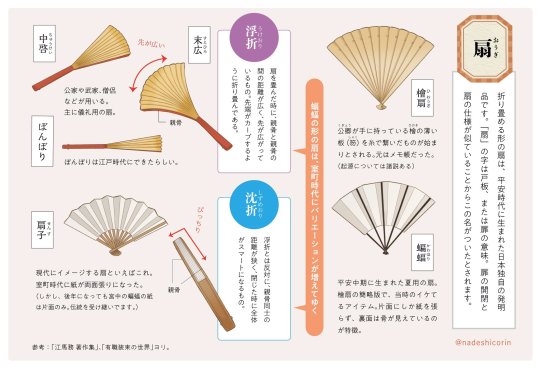

Types of ôgi (folding fans), handy reference chart by Edo-era lover Nadeshico Rin. Please note this overview doesn’t cover all Japanese fan variations, for example also see maiôgi (舞扇 dance fan), tsunenoôgi (常の扇 common fan), shizume (鎮扇 noh fan), rokkoku (六骨 Kamakura fan), gunsen (軍扇 war fan), etc etc.
Fans were first imported to Japan from China, and were used from the start as symbols of status and refinement. Chinese fans were originaly rigid ones (see modern uchiwa), and according to Rin, foldable ones appeared in Japan during Heian period free from Chinese influences.
In the past, word ôgi 扇 meant “sliding door” (today 戸板 toita), and overtime lost its original meaning to only designate folding fans.
From right to left, you can see on first picture the oldest known Japanese folding fans:
Hiôgi (檜扇 - ひおうぎ) - hinoki cypress fan, used by Heian nobles. Some theorise those were first made from shaku 笏 (a type of ritual wooden baton used in Shinto) hold together by threads. Hiôgi were symbol of power and formal ones were heavily decorated with painted sceneries and dangling colorful ribbons.
Kawahori (蝙蝠 - かわほり) - lit. «bat» fan, appeared around mid. Heian period. Those were simplified hiôgi meant to be used in Summer. The lighter frame had paper pasted on one side, somehow giving the aspect of a bat wing when seen from reverse.
From there, kawahori fans morphed during Muromachi period:
Ukeori (浮折 - うけおり) or «floating» types which had unmovable handles and looser top parts. Some examples are: - Suehiro (末広 - すえひろ) - spread out fan, with curving ribs - Chûkei (中啓 - ちゅうけい) - ceremonial fan, used by nobles, samurai and monks - Bonbori (ぼんぼり) - the little brother of the chûkei which appeared during Edo period (bonbori are paper covered lanterns I don’t know if those and this fan are linked).
Shizumeori (沈折 - しずめおり) or folding types, where whole structure can be collapsed, looking quite sleek and refined. Most known fan of this type is: - Sensu (扇子- せんす) - folding fan, which is the most spread nowadays. During Muromachi period, paper began to be put on both sides, hiding the ribs. Interestingly, Imperial court still favors one side paper only even today as a nod to the original design.
During Edo period, folding fans use spread among the whole population and their ribs started to get more and more decorated with sukashi (透かし openwork). Some popular designs included:
Hanabishi (花菱 - はなびし) - flowery diamond-shaped cut-out
Nekomasukashi (猫間透し - ねこますかし) - «cat door» cut-out (sometimes also called nekome/猫目/cateye)
Kamatarisukashi (鎌足透し - かまたりすかし) - «heels apart» cut-out
Oosukashi (大透し - おおすかし) - big cut-out
Rokkotsusukashi (六骨透し - ろつこつすかし) - «six points» cut-out
Chôjisukashi (丁子透し - ちょうじすかし) - «clove» cut-out
Nagachôjisukashi (長丁子透し - ながちょうじすかし) -«long clove» cut-out
#japan#fashion history#history#Nadeshiko Rin#fan#folding fan#hand fan#ogi#ougi#Sensu#hiogi#kawahori#Suehiro#Chukei#Bonbori#sukashi#cut-out#references#ressources#Edo period#heian period
374 notes
·
View notes